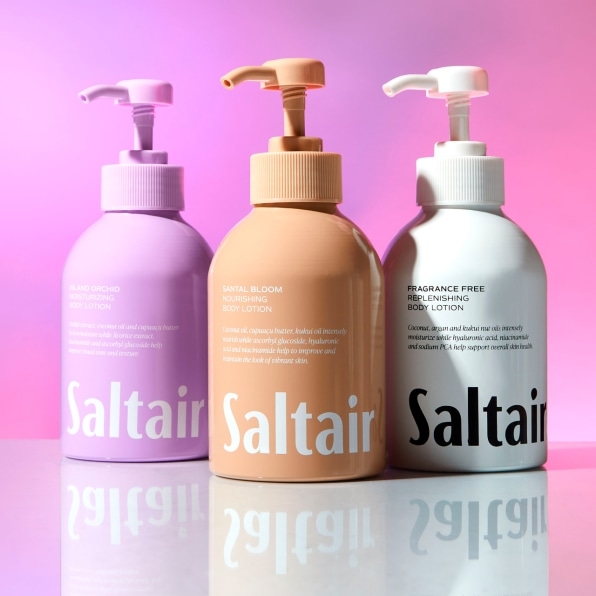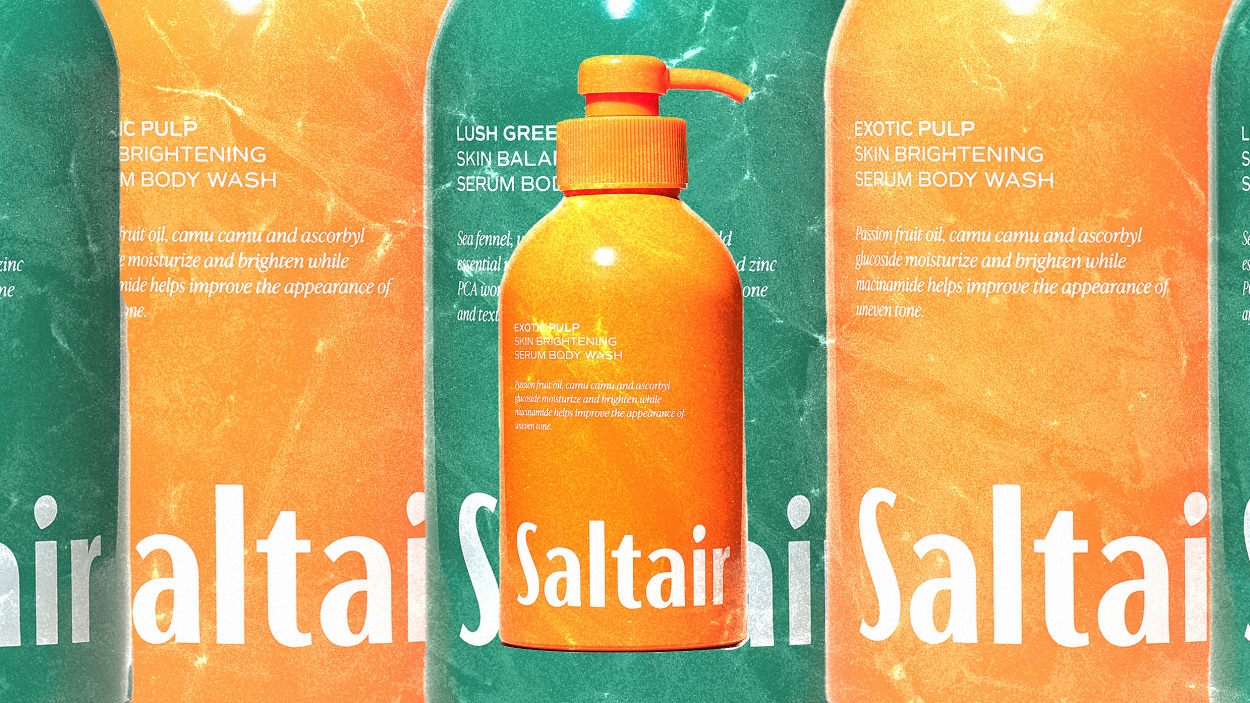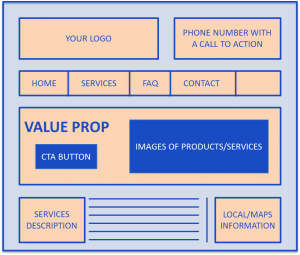Four days after launching the body and hair care brand Saltair, Iskra Lawrence had a problem. The model turned cofounder had just released her first line of products in 100% aluminum bottles, a choice she and her team had made for the material’s recyclability. Now, some customers receiving these bottles reported dents and dings in the colorful aluminum.

The Saltair team had an emergency meeting. Shipping replacements was too costly and would add to carbon emissions. Stuffing with Styrofoam or bubble wrap was not an option. The product inside the bottles was in perfect condition, and yet, customers were clearly disappointed.
Instead of sending replacements, Saltair reframed the dilemma with hashtags like #BottlePositivity and #ShowUsYourDimples on social media, encouraging customers to accept imperfect bottles for sustainability’s sake and accept their bodies for their own “dents” or dimples––a message that hits at the core of Lawrence’s personal mission of promoting body positivity.
“I think as soon as we owned it, and we put out the blast on social media, on email…people wanted to share it and they weren’t like, ‘Oh, it’s not perfect. I can’t put it in this video or do this unboxing,’ and that was just liberating, I think, for everyone,” Lawrence says. Since then, complaints about dents and dings have almost ceased entirely, Lawrence says. Though Saltair did add a cardboard insert in packages for extra protection, the brand did not compromise its sustainability goals––it doubled down on its message.
Going greener
Sustainability is a growing issue for consumers, with 90% moving toward purchasing more environmentally sustainable products. Plastic packaging is increasingly unpopular and restricted, with California setting the country’s most severe rules on plastic packaging this summer. The green packaging market is thus growing and driving interest in alternative shipping solutions and materials like paper, glass and aluminum, the option that Saltair embraced.
Aluminum has a higher recycling rate than plastic, according to the Environmental Protection Agency, and it is lighter than steel. That said, its initial production process entails more carbon emissions. Though it’s far from the singular, perfect solution, aluminum seems to be emerging as an attractive option for brands moving away from plastic and touting sustainability and recyclability.
Recycled aluminum made up 59% of all aluminum shipped in Apple products in 2021. In recent years, both PepsiCo and Coca-Cola announced plans to use aluminum cans for water. This year, Novelis announced its plans to open the largest aluminum-rolling plant in the U.S. to meet an increasing demand for aluminum beverage cans. Brands with celebrity founders from Jason Momoa to Harry Styles are choosing aluminum for their products. “Aluminum containers are probably the most popular, recyclable things at the moment, and they dent very easily,” says Howard Baker, president of Product Integrity Laboratory. He added that in the beauty and cosmetics industry, in particular, consumers tend to care about the aesthetics of packaging.
In July, Flamingo Estate, a brand that makes candles, soaps, condiments, and more, switched to aluminum bottles for most of its bath and body products to increase sustainability. The brand experienced mixed feedback on the look, says head of product development Victoria Corrales. Some customers thought the material looked chic and others missed the brand’s old glass bottles. “I don’t know that they care that it feels more sustainable, it’s lighter weight, shipping and everything else that goes into that goes into that equation in trying to minimize our impact. They really care about that aesthetic,” Corrales said.

Higher expectations
Customer expectations are exceptionally high for packaging. In fact, a recent study with consumer focus groups concluded that “consumers expect a sustainable package to do everything a standard package would do and not be harmful to the environment (environmentally friendly) at the same time.” But Lawrence believes that with smart packaging choices and the right messaging, consumers will buy into sustainability––and any dents or dings that may come with it.
A 2022 survey found that sustainability is a top five value driver for 66% of consumers in at least one category, from consumer goods to energy to construction and home. The sentiment is growing, according to another 2022 survey: 51% of respondents said sustainability mattered more to them now versus 12 months ago, and 49% have paid a premium for sustainable or socially responsible products in the same time frame.
Despite their enthusiasm for sustainable products, some customers face barriers, including affordability, access, and even confusion about when a product or service is actually sustainable. On top of that, Baker says that there’s no official definition for what constitutes green packaging. “For whatever one might come up with as a ‘green package’ there will be those who will say it’s not ‘green’ enough,” he said. “It takes too long to return to natural, benign materials in a landfill or compost pile. It takes too much precious energy to make them.”
A clear message
The skincare Dieux Skin uses aluminum tubes for its moisturizer, Instant Angel. A blog post on its site breaks down both the price tag and the sustainability reasoning behind choosing aluminum for its packaging, as well as a tutorial on how to use the aluminum tube with a “squeeze key” without puncturing the material (a problem which, according to Instagram comments, some consumers have encountered). “Aluminum tubes definitely have a learning curve so thank you to everyone that has reached out,” says a post on the brand’s Instagram. “What we Dieux promise is once you get the hang of aluminum, it’s glorious.” Like Saltair, Dieux Skin asked customers to adjust their expectations rather than compromise on sustainability.
Clear messaging about sustainability plays a crucial role in explaining why certain material or packaging was chosen and how consumers may need to adjust their expectations accordingly. Brands are making intentional and inventive moves with both their materials as well as their packaging and shipping solutions. Flamingo Estate, in addition to its aluminum products, uses crinkle paper and Flexi-Hex, sustainable paper packing sleeves, to ship their products and avoid damage.
Baker points to corrugated paper and its ability to protect glass bottles, like boxes of wines, and other somewhat fragile materials. The corrugated paper market is on the rise, as is biodegradable paper and plastic packaging. Some brands are now using biodegradable packing peanuts and boxes, vacuum sealing to keep packages small, and compostable mailers, while others are working with providers that offset carbon emissions.
Taking steps toward sustainability could involve some initial hurdles in packaging engineering and consumer perception, but there’s an opportunity for long-term payoffs: Millennial and Gen Z consumers are gaining spending power and care about sustainability more than other generations. And if Saltair provides any example, it is that sustainability goals can be communicated––and consumers can be convinced to listen. In the last three months, Saltair’s business has tripled.
“We’ve been able to take a stand and say we’re not going to strive for perfect, we’re going to strive for the best we can, but we know that that doesn’t impact our product or its experience and how much you’re going to love it,” Lawrence says. “I hope that other brands can just see that and not be so scared to step into this space because the impact of the product…that’s going to be more important for your brand and business.”
(9)








